
Rufus Update their Live Profile
With only three days to port Rüfüs’s Coachella live show over to the Avid S6L and develop a new muscle memory, FOH Engineer Cam Trewin had to trust what his ears were telling him… that it was all worth it.
Standing front and centre on the floor of Adelaide Arena, Rüfüs FOH engineer Cam Trewin was torn between where his muscle memory was telling him to go and where his ears were beckoning him.
For Rüfüs’s Australian run of shows, Trewin had opted to try out Avid’s new flagship live console, the S6L. They’d just stepped off the plane from a North American tour during which he’d meticulously dialled in his Profile show in the lead up to Coachella. The jet lag was giving him the jitters and he was questioning the cogency of jumping on a new console on the eve of an arena tour. After one day in Novatech’s Adelaide factory getting the rundown, he had just two days of pre-production in Adelaide Arena to get the set back to or better than Coachella standards.
The Venue software compatibility worked a treat — his session had carried across from the Profile one-to-one as advertised, and his head amp gain settings stayed put — but without any Waves integration on the S6L, all the fine detail he’d spent months crafting on the Profile was gone. “I ended up tipping a Profile as well, because I freaked out a little when I first hit the ground,” said Trewin. “I didn’t feel comfortable at all.” Novatech kindly put in a third iso split so Trewin could pass everything through both consoles at the same time. With a direct comparison between the old Profile and new S6L, the sonic quality was winning him over fast: “You can really hear the new architecture; the default 96k sample rate, and the 64-bit AAX DSP plug-ins.”
There were two areas in particular where Trewin noticed immediate improvements. “My EQ biases are really different from the Profile to this,” he said. “I was winding heaps more back in on the S6L; my Profile EQs are a lot more aggressive, especially on the vocal.” The other difference was in his parallel ‘drum slam’ bus: “Usually I’d use a Waves Pye compressor or something really aggressive, but I’m just using Smack and finding a lot of front end in it.”
Overall, once he’d committed to learning the new console, Trewin reckons by the end of the three days he felt fluid on the S6L. “The muscle memory has come really quick in comparison to the Profile,” he said. “Even though the layout is quite different, it’s very intuitive. It was a little scary at first because I expected the Profile, but I didn’t want to use the mouse or the screen, I wanted to use the S6L’s encoders and faders, which feel really good.”
REBUILDING YOUR PROFILE
The other reason he had Novatech tip the Profile was to recall a few favourites in a different form. He’d been a heavy user of Waves’ C6 multiband compressor. Because you can’t see offline plug-in settings, he used the Profile as a recall sheet so he could match up starting points on Avid’s internal multi-band dynamics plug-in. “I was using the C6 to notch out some really problematic frequencies in the spill of the live drums bleeding into the mic,” explained Trewin. “Now I’ve wound a lot back in and I’m not carving as much away.”
There were a few of extra plug-ins he purchased to help mix the all important main vocal; the Cranesong Phoenix tape emulation and Sonnox plug-ins. “I was really heavily dependent on them with the Profile. Room to room I’ll click between Phoenix’s different tape types, biases and brightness, depending on whether I want more low mids or top end lift from the vocal in that room.
“I also used the Oxford EQ to notch out a few spots here and there, with a big 20kHz GML top end lift in the vocal to get a bit more presence.
Now relying on more of Avid’s internal plug-ins, he also uses the “Avid multi-band dynamics to reign in a little of the high-mid and top end information, and the BF-2A as a basic limiter.”
The track count for Rüfüs’s live show isn’t huge. It sits around 36 tracks, with a mixture of playback and live elements. Over the two years since Trewin has been mixing the band, they’ve brought more and more parts off the playback system and onto the live stage. Originally, the Ableton computer would run almost everything, including the soft synths lead singer Tyrone Lindqvist and keyboardist Jon George played via onstage MIDI controllers. It was putting an enormous load on the computer as well as sounding a bit bottlenecked. These days, alongside James Hunt’s live drums, all the album samples are loaded onto a number of Roland SPD-Xs, the keyboard parts are played direct from Nord Electro 5s, some of the basslines come from an onstage Roland TB-3, and occasional percussion elements are played live onstage.
Now, with more tracks to play with, and better splits from the playback track system, Trewin has a bit more to manage. The S6L’s new user layout page lets him customise an entire fader bank of the 32 fader console, which Trewin spends almost all his time on during the show: “I can condense it all to my key element tracks like keyboards, TB3s, guitar; key element VCAs like vocals; and effects returns. I spend pretty much all my time on that layer and very rarely jump out. Once the kit’s balanced, it’s just a push between the dry and parallel bus. If I want to though, I can just break out that VCA input.”
I was winding heaps more back in on the S6L; my Profile EQs are a lot more aggressive, especially on the vocal

TWEAKING WITH A V
The new architecture also means Trewin can run out 64 channels via AVB over a single ethernet cable between the S6L and his Macbook Pro. With a simple button press for V-checking, it’s also far more convenient than the 32-channel optional Firewire card on the Profile, as he can now one-for-one his entire show.
A big part of Trewin’s preparation is making sure the programmed and live elements sit together well. The playback tracks feature all the drums on the album, with the live drums adding a whole new live kit over the top.
“I’ve spent two years trying to massage the two because I don’t want it to be one of those shows where you’re wondering if there is or isn’t a drum kit there,” said Trewin. “I want it to sit at a point where if you take away the live kit you really feel the energy is gone.”
He will often sit there looping the V-check with the kicks solo’d in place, getting them to sit right. First, he gets up onstage to tune the kit, then he usually ends up gating the sequenced kit to limit the low end tail of those long 808 hits. It’s the same at the other end, cueing up the two sets of hats and using EQ and multi-band compression to get them sounding the same. Through trial and error, Trewin has found that matching them is best. “If they sound really different, one tends to dominate the other,” he explained.
At the Festival Hall show in Melbourne, the proof was in the pudding. At points during the show, like after the song Tonight, the three members of Rüfüs just had to stand around for half a minute grinning from ear to ear waiting for the crowd to stop cheering. While the crowd was deafening the mix was incredibly well balanced. Even the searing synths on You Were Right, which are more subdued on the album, perfectly lifted the song’s energy without taking your head off. Trewin and the band have nailed the transition from programmed to live instruments, and by all accounts the transition to the S6L has only added to the sound of the show. If you love engaging sound then the Rüfüs live show is definitely worth checking out.
You can find out more about Cam Trewin in our Quick Mix column from Issue 112.

Tyrone uses a Malekko Spring Chicken reverb pedal, Redwitch Empress chorus, and the Eventide H9 Harmonizer, which has been really critical for the show. The Sansamp also adds a little bit of grit. It’s DI’d straight out of the Sansamp, which I prefer. We’ve talked about getting an amp, but the DI works really well for clarity and limiting spill.
We have the Radial ProD8 and JD6 DI racks connected to two W1 Whirlwind connectors which are multi-pinned out straight into a drop. We’re also running a Sennheiser G3 wireless for Tyrone’s guitar.


There’s a MIDI send and receive from James’ MPD to the playback rack. It’s connected to a redundant MPD our playback tech has for track starts or any other track cues if James can’t hit them. The guys are running JH Audio JH16 in-ears. We’ve tried butt kickers with James before, but there’s a little latency he wasn’t vibing, so we’re touring B2 subs as low end fill onstage.
John’s Roland SPD-X has all the samples from the album loaded into it. He runs the Korg MS-20 with the Moog Minifooger delay pedal off to the side for sweeps. There’s also MIDI in coming off the playback rack.

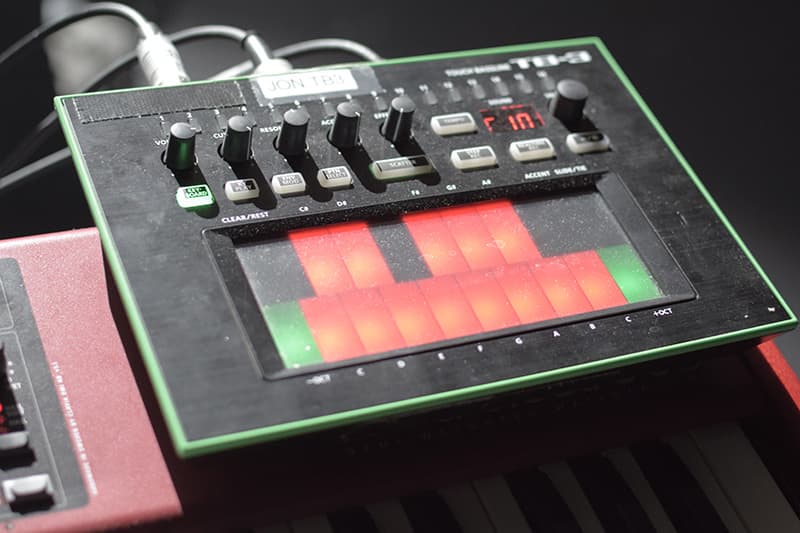

John runs a Roland Bitrazer pedal inline with the Nord Electro for bitcrush effects. He plays the Roland TB3 live, but it also has MIDI programming coming into it.
“I’ve had Tyrone on an Audix OM7 for two years now. We’ve cycled through a lot of mics and this works best for his low output. The tight hypercardioid pattern really helps, it’s got nice low mid clarity and it’s not hyped in the top end. It does need a lot of gain, but he’s adapted and his mic technique really suits it. He wanted to go wireless, so we bought a Soundtools adaptor from Ratsound which connects it to the Shure UR wireless body. The Shure body has really changed the sound of it, but I like the change.”


I use a Shure Beta 91 inside the kick and Audix D6 out, which works for this style of music. I lean towards the 91 a little more for the attack. Snare has a Shure Beta 57 on top and a normal 57 on bottom, Sennheiser 904s for rack and floor, and Sennheiser MK4 large diaphragm condensers as overheads. He’s playing a lot of shakers into those mics and they give me a nice image. I’ve got the Audio-Technica AT450s on the ride and hi-hats. I love how close you can get with the side address, I’ve had them for years. They’re just a good sounding workhorse, which is the way I feel about all these mics.
Tyrone uses the same keyboard setup as John; Nord Electro 5 with the Bitrazer filter pedal. He uses the cowbell in critical moments in the show. I pick it up through the vocal mic because there’s so much gain. There’s a lot of percussion in the playback, but I like to keep the live elements in the show.


As well as samples loaded into his SPD-X, James also uses the Akai MPD for track playback. The Roland V-Drum has additional pad effects with an inline Boss DD7 digital delay for noise sound effects in song transitions.



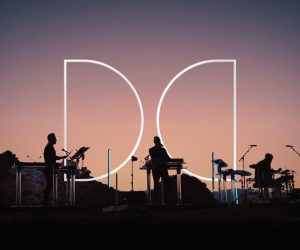
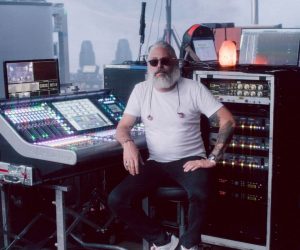
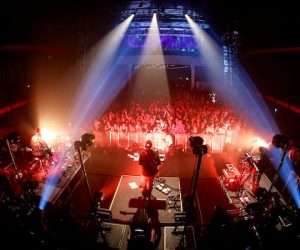

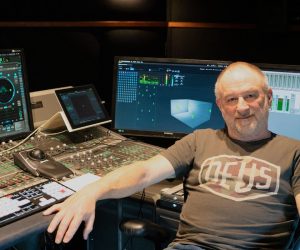








RESPONSES